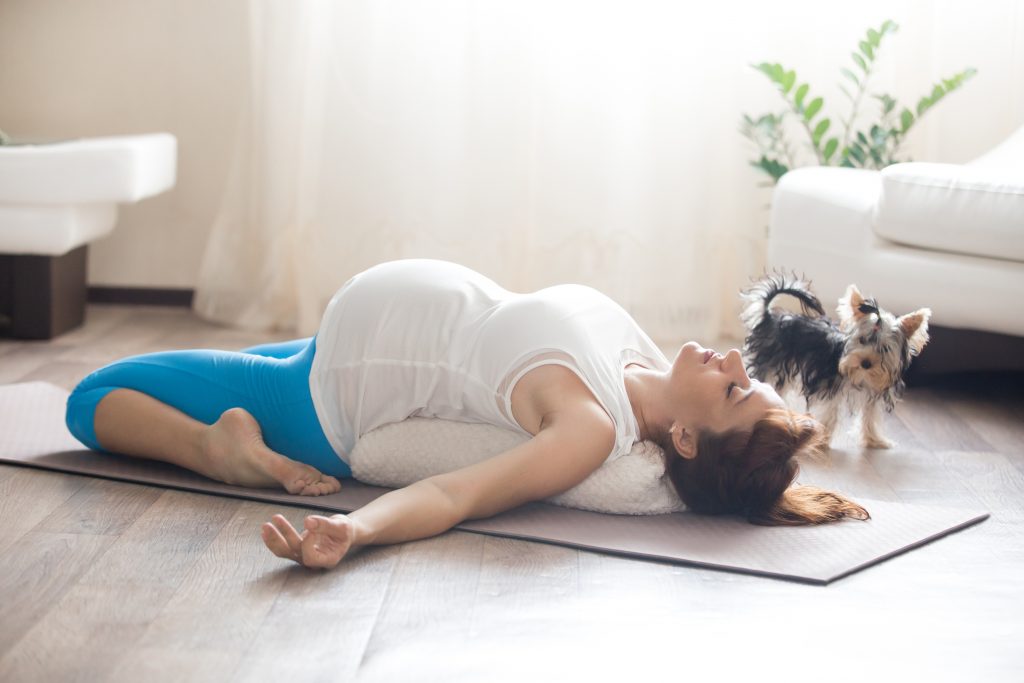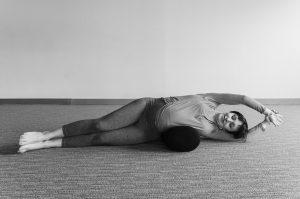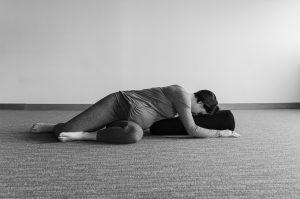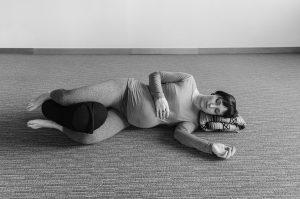By Bernie Clark, May 1st 2021

Every yoga class has at least one posture where students are lying on their backs. Even the most active classes end in some sort of Shavasana. Should students who are pregnant join the rest of the class in lying supine on their backs? Does it depend on how far the pregnancy has advanced? What is the current medical advice?
Science evolves, refining our understanding, uncovering new views based on new data and experiments. Since the sixties, scientists have known that lying supine late in pregnancy compresses the inferior vena cava, restricting blood flow to the heart.[1] During the second and third trimester, with the fetus growing larger, lying on the back positions the fetus atop the vena cava, compressing it and reducing blood flow through it by up to 85%.[2] The blood is shunted to smaller vessels in order to flow back to the heart, such as the azygos vein and vertebral venous system. However, lying on the side reduces the occlusion and allows more blood to flow. Some studies found a correlation between sleeping supine and miscarriages.[3] Based on these findings, doctors, therapists and yoga teachers advised avoidance of lying on the back during the second and third trimesters.

Problems from compression of the vena cava can lead to supine hypotensive syndrome. Symptoms may include pallor, dizziness, low blood pressure, sweating, nausea and increased heart rate.[4] However, this affects only about 8% of cases, usually in the second or third trimester.[5] Many people lie on their backs during their pregnancies and do not suffer low blood pressure, headaches or dizziness and have healthy babies. Or, if they do feel discomfort, they intuitively know to move and change posture. The studies showing a correlation between sleeping on the back and miscarriage are not definitive: the sample groups are small and sleep behavior reports are based on the participants’ memories. Plus, these studies looked at individuals who lay on their backs for the whole night, without getting up to go pee or change position. No yoga pose is held that long. Based on natural human variation, some yoga teachers have changed their advice from “never lie on your back” to “it may be okay to lie on your back; notice how you feel.” Indeed, in The Complete Guide to Yin Yoga, 2nd edition, I wrote:[6]
“Women are often advised not to lie on their backs because the weight of the baby compresses the vena cava, a vein that brings blood back to the heart. However, this caveat is often overdone. If all the blood returning back to the heart was being stopped, you would notice that! No woman would stay in a place where this was happening, so don’t become overly protective. Pregnant women are not fragile glass figurines: they are a lot stronger than most people (I am thinking mainly of male teachers) give them credit for. If you find lying on your back nice, go for it. If it doesn’t work for you, don’t do it.”
Would I write the same advice today? Not quite.
Current View
Science marches on! While the risk is small and miscarriages rare from lying on the back for a few minutes, recent research has found that the fetus changes its behavior when the parent changes posture.[7] The fetus is usually in one of four states:
-
- F1: asleep and quiet
- F2: asleep but active
- F3: awake but quiet
- F4: awake and active
When lying supine, fetal activity is reduced. A healthy fetus will adapt to the potential stress by shifting to a lower oxygen consuming state and moving into the F1 state.[8] Another marker of fetal wellbeing is fetal heart rate variability (FHRV): the higher the variability, the healthier the fetus. Unfortunately, this too reduces when the parent lies supine. So, it seems that while pregnant people may be fine on the back, the change in blood flow can affect fetal development. When the parent’s blood flow is reduced, the fetus puts its own development on hold and goes into a resting state.
Other Positions
Lying on the back reduces cardiac flow by almost 17% compared to lying on the left side.[9] Clearly, position makes a difference. A 2019 study examined the effects of four maternal positions:[10] lying on the back (supine), semi-reclined, lying on the right side and lying on the left side. The fetus spends almost four times as much time in the active and awake state (F4) when the parent is lying on the left side compared to lying supine. Lying on the right side is almost as good as lying on the left side, but the fetus will spend almost twice as much time in the F1 state when the parent lies on the right side versus the left side. Lying on a bolster angled to 30° is better than lying supine, but not as good as lying on either side. The following table summarizes the effect of the parent’s position on fetal state.
|
Maternal posture |
F1: Asleep and quiet |
F2: Asleep and active |
F4: Awake and active |
|
Lying on left side |
13 |
91 |
11 |
|
Lying on right side |
28 |
91 |
8 |
|
Semi-reclined |
23 |
113 |
2 |
|
Supine |
45 |
83 |
3 |
Table 1: Blocks of time spent in fetal behavioral states vary by maternal position.[11]
Time Makes a Difference
Time is obviously a factor. How long does it take for the effects of a particular posture to arise? The data in table 1 was based on 30 minutes in each position. Yoga postures are not held so long, but in Yin Yoga, students may spend that much time in total on their backs. A flow including Saddle, Bananasana, Reclining Twists (if not done on the side)[12] and Shavasana can add up to 30 minutes or more. If counterposes are done lying on the back, the total time may be longer. It is reasonable to assume that a yoga practice with a lot of reclining postures will change fetal behavior.
Today, my advice to someone who is pregnant and doing a reclining pose would be to:
-
- Listen carefully to your body—any signs of dizziness, nausea or rapid heartbeat suggests sitting up;
- Try some alternative positions that either raise the upper body (reclining on one or more bolsters) or turn to a side, preferably the left side (see the following figures for ideas);
- Sit up between reclining poses for a moment;
- Intermix sitting poses in between reclining postures;
- Reduce the time in the postures. For example, Yin Yoga students may stay for only 2 ~ 3 minutes.
And above all, check all this with your health-care team! Work with them to develop a yoga practice that works best for you and your baby.




____________
[1] Kim DR, Wang E. Prevention of supine hypotensive syndrome in pregnant women treated with transcranial magnetic stimulation. Psychiatry Res. 2014;218(1-2):247-48. doi:10.1016/j.psychres.2014.04.001.
[2] Lanni SM, Tillinghast J, Silver HM. Hemodynamic changes and baroreflex gain in the supine hypotensive syndrome. American Journal of Obstetrics and Gynecology. 2002;187(6):1636–41.
[3] Bernie Clark, The Complete Guide to Yin Yoga, Second Edition (Vancouver: Wild Strawberry Productions, 2019), 204.
[4] Stone PR, Burgess W, McIntyre JP, Gunn AJ, Lear CA, Bennet L, Mitchell EA, Thompson JM, Maternal Sleep In Pregnancy Research Group, The University of Auckland. Effect of maternal position on fetal behavioural state and heart rate variability in healthy late gestation pregnancy. J Physiol. 2017 Feb 15;595(4):1213-21. doi: 10.1113/JP273201. Epub 2016 Dec 11. PMID: 27871127; PMCID: PMC5309385.
[5] Warland J. Back to basics: avoiding the supine position in pregnancy. J Physiol. 2017;595(4):1017-18. doi:10.1113/JP273705.
[6] Note: cardiac flow is not the same as blood flow through the inferior vena cava. While flow through the inferior vena cava can be reduced up to 85%, blood flow through the azygos vein more than doubles. Overall, blood flow from the heart is only reduced about 17% when a gravid woman is lying on her back. See Humphries A, Mirjalili SA, Tarr GP, Thompson JMD, Stone P. The effect of supine positioning on maternal hemodynamics during late pregnancy. J Matern Fetal Neonatal Med. 2019 Dec;32(23):3923-30. doi: 10.1080/14767058.2018.1478958. Epub 2018 Jun 3. PMID: 29772936.
[7] Stone et. al.
[8] The researchers measured the fetal states over five minute blocks of time. They assigned to the block the fetal behaviour state that occurred the most in that block. Note that almost no time is spent in F3: Awake but quiet. See Stone et. al.
[9] Even slightly angling the abdominal area while in a Reclining Twist can make a difference. A wedge or folded blankets under one hip can lift that side of the body and alter the position of the fetus relative to the vena cava.
[10] Kerr MG, Scott DB, Samuel E. Studies of the inferior vena cava in late pregnancy. Br Med J. 1964;1(5382):522.4-533.
[11] Humphries A, Mirjalili SA, Tarr GP, Thompson JMD, Stone P. The effect of supine positioning on maternal hemodynamics during late pregnancy. J Matern Fetal Neonatal Med. 2019 Dec;32(23):3923-30. doi: 10.1080/14767058.2018.1478958. Epub 2018 Jun 3. PMID: 29772936.
[12] Heazell A, Li M, Budd J, et al. Association between maternal sleep practices and late stillbirth – findings from a stillbirth case-control study. BJOG. 2018;125(2):254-62. doi:10.1111/1471-0528.14967.
[13] Photos of Carla Johnson, a Vancouver based yoga teacher and mother, are by Tom Belding (www.tombelding.com) © 2019.
